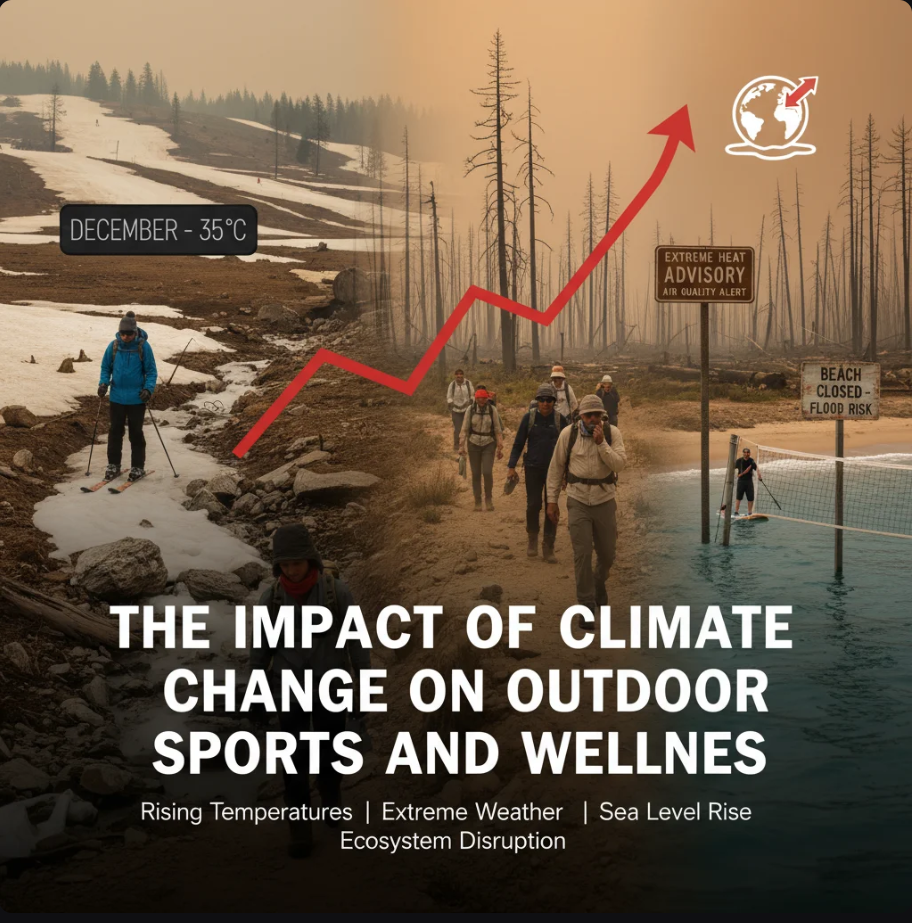Explore how climate change is transforming outdoor sports and wellness. From rising temperatures to shifting seasons, discover how athletes adapt to a changing planet.
Outdoor sports have always represented freedom — the open air, the connection with nature, and the pursuit of wellness through movement.
But as the planet continues to warm, the world’s playgrounds are changing.
From hiking trails and beaches to ski resorts and marathon routes, climate change is reshaping how, where, and when we can safely enjoy outdoor activities.
This is not just an environmental issue — it’s a wellness one.
The health of the planet and the health of the people are now intertwined like never before.
1. Rising Temperatures and the Risk of Heat Stress
One of the most direct consequences of climate change is the increase in global temperature.
For outdoor athletes and fitness enthusiasts, this means a higher risk of heat-related illnesses — dehydration, exhaustion, and even heatstroke.
In marathon events, triathlons, and cycling races, organizers are already adjusting:
- Earlier start times to avoid peak heat.
- Additional hydration checkpoints.
- Real-time temperature monitoring for participants.
The human body performs best within a narrow thermal range. As heat extremes become more common, training safely outdoors is becoming a growing challenge.
“Athletes now have to adapt not only to competition but to the climate itself.”
2. Air Pollution and Respiratory Health
Climate change worsens air quality through increased wildfires, smog, and ozone levels.
For outdoor athletes, poor air means more than discomfort — it affects performance and long-term health.
Studies show that even short-term exposure to polluted air can:
- Reduce lung capacity during endurance exercise.
- Increase inflammation in respiratory pathways.
- Heighten the risk of chronic conditions such as asthma.
Many sports federations now integrate air quality indices into training decisions, delaying or relocating events when pollution exceeds safe levels.
3. Changing Seasons, Shifting Sports Calendars
Climate change is also distorting seasonal patterns, disrupting sports that depend on predictable weather.
- Winter sports like skiing and snowboarding face shorter seasons and less reliable snow.
- Summer events are increasingly threatened by extreme heat and storms.
- Even surfing and sailing competitions are being affected by irregular wind and tide patterns.
Athletes and event organizers are responding with climate adaptation strategies:
- Moving events to higher altitudes or cooler months.
- Investing in artificial snow or hybrid surfaces.
- Developing cross-season training programs for unpredictable conditions.
The rhythm of global sports is being rewritten by the climate crisis.
4. Impact on Training Environments and Infrastructure
Outdoor training spaces — from running tracks to parks and coastlines — are also at risk.
Sea-level rise, flooding, and droughts are damaging sports facilities and natural landscapes.
Examples include:
- Coastal running paths eroded by tidal surges.
- Football fields and golf courses affected by water restrictions.
- Climbing sites closed due to landslide risk or melting permafrost.
In response, cities are redesigning climate-resilient sports infrastructure, using materials and layouts that can withstand heat, water, and wind stress.
5. Mental Wellness and the Loss of Nature Access
Outdoor activities are more than physical exercise — they’re a source of mental restoration.
But when pollution, temperature, or weather extremes make these spaces unsafe, the impact reaches deeper into psychological well-being.
Reduced access to natural spaces correlates with:
- Higher levels of anxiety and depression.
- Lower motivation for physical activity.
- Disconnection from community and environment.
The irony is clear: the very thing that supports wellness — nature — is becoming less accessible, creating a loop between environmental decline and mental strain.
6. The Rise of Eco-Adaptive and Sustainable Sports
Amid these challenges, innovation is emerging.
Athletes, brands, and wellness advocates are pioneering eco-adaptive sports practices that align health with sustainability.
Trends include:
- Eco-marathons designed around reforestation campaigns.
- Solar-powered gyms and outdoor fitness equipment.
- Sustainable surfboards, shoes, and apparel made from recycled or plant-based materials.
- Virtual and hybrid races that reduce travel emissions.
The message is clear: outdoor sports must evolve not just for performance, but for planetary responsibility.
“The future athlete is not just fit — they’re environmentally conscious.”
7. Global Policy and Sports Responsibility
Major sports organizations are recognizing their role in the climate equation.
The IOC (International Olympic Committee), FIFA, and other global bodies have begun implementing:
- Carbon-neutral event strategies.
- Green infrastructure for stadiums and training centers.
- Partnerships with environmental NGOs to offset event emissions.
Climate action in sports is no longer optional — it’s essential for the industry’s survival.
By embedding sustainability into its core, the global sports community becomes both a role model and a catalyst for broader societal change.
8. The Future: Climate-Adaptive Wellness Culture
Looking ahead, outdoor sports and wellness will increasingly rely on data, innovation, and mindfulness.
- AI-powered apps will adjust training plans based on weather and pollution data.
- Smart fabrics will monitor hydration and temperature regulation.
- Virtual reality may recreate outdoor environments safely indoors.
This shift doesn’t mean abandoning nature — it means learning to train with it, not against it.
A climate-adaptive wellness culture is about resilience, awareness, and balance between personal health and planetary health.
Conclusion
Climate change has already transformed the world’s fields, mountains, and oceans — and with them, the way we play and stay well.
Outdoor sports, once symbols of freedom and vitality, now stand at the frontline of environmental reality.
Yet, this challenge also offers opportunity: to rethink how we move, how we care, and how we connect with the Earth that sustains us.
“Protecting the planet is no longer separate from fitness — it is fitness on a global scale.”
Baca juga :














